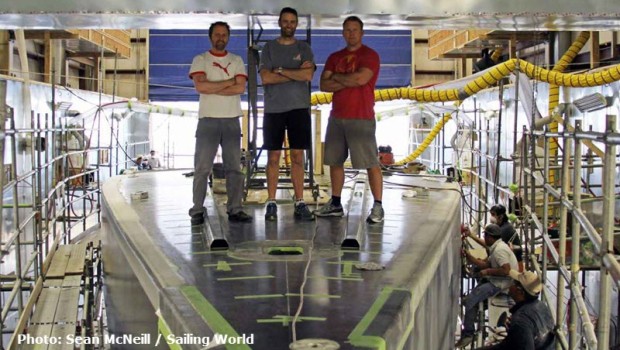Cooking The Machine: Jim Clark’s 100-footer
Published on July 2nd, 2014
Tim Hacket and Brandon Linton, both Australians, have been building racing yachts since they were apprentices at McConaghy Boats in the early 1990s. They’ve seen firsthand the expanded use of carbon-fiber in the construction of those yachts, and now they’re deep in the midst of one of the most complex builds they’ve ever undertaken.
The duo are respectively the project manager and build manager for Jim Clark’s new mega-speedster nicknamed “NewCubed” under construction at Hodgdon Yachts in Boothbay Harbor, Maine. They’ve built some impressive boats through the years, for America’s Cup and Volvo Ocean Race teams, and they’ve seen the use of carbon become more refined and detailed to maximize its potential and avoid catastrophe.
“It was easier working with carbon in the early days because its full range of engineered properties weren’t known then, so most things were overbuilt to allow a greater safety margin,” says Linton. “Nowadays, you can’t just lay up the fabric and cook it because the engineers are pushing the limits. Now it all has to be prepared perfectly.”
“Every time you cook a piece, however big or small, you have to follow the procedures exactly or it could lead to voids and problems,” says Hacket.
Measuring in at 100 feet LOA and 26 feet wide, “NewCubed” has a lot of carbon-fiber. The joined hull and deck have 8 tons combined of carbon fiber, Kevlar core, and pre-impregnated resin. The keel bulkhead alone has 1,000 square meters (10,763 square feet) of the black stuff. Much of that carbon has been laid over a Kevlar core varying in thickness between 30 and 40 millimeters.
“The designers prefer Kevlar for the core because of its properties; it has better sheer values when compared with Nomex,” says Hacket. “But it’s a little harder to work with and requires more prep time. When it arrives it has a fuzzy layer that needs to be sanded down before it can be bonded.”
Kevlar core, however, is absent in the hull sections forward of the keel. That area of the boat is monolithic carbon fiber measuring up to 7 millimeters thickness, and that is where the “NewCubed” project becomes more complicated for Hacket and Linton. – Sailing World, read on
Note: The boat’s first appearance is scheduled to be the Rolex Sydney Hobart Yacht Race in Australia on December 26.









 We’ll keep your information safe.
We’ll keep your information safe.